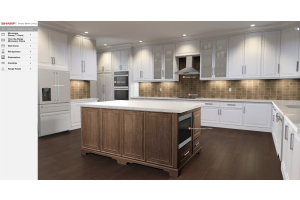How To Improve Your Kitchen Ventilation
It’s common to worry about air pollution when walking down a busy street or passing construction, but what about the air quality in your home? While delightful scents wafting from the stovetop don’t exactly scream danger, there are byproducts of cooking that linger in the kitchen even after the elements are turned off and the dishes are done.
The best way to combat unwanted odors and prevent air pollution is to improve kitchen ventilation. It can be as simple as opening a window next time you sauté or turning on a fan in a nearby room. However, for a more permanent solution to your problem, here are three tips to drastically improve your indoor air quality:
1. Upgrade your ventilation system.
A ventilation system is the best way to keep your kitchen air clean; plain and simple. Any type of ventilation hood will filter out smoke by creating airflow as you cook with the click of a button. You’ve probably noticed that there are many different options when it comes to range hoods. Some don’t even look like hoods at all. Depending on the layout of your kitchen, you might want to consider these two types of ventilation hoods:
Downdraft ventilation: A sleek solution to your kitchen’s ventilation issues, a downdraft system will improve your indoor air quality without impacting the look of your kitchen. They integrate into your countertop or cooking appliance and draw fumes down to keep them from circulating your kitchen.
Overhead range hoods: These systems pull fumes upwards to get them out of your cooking space and they come in a variety of styles. Wall-chimney hoods, island hoods, and undercabinet hoods are just a few options available. If you haven’t invested in a new range hood in a while, some new features from our vendors include dishwasher safe filters, LED lighting, and upgraded controls for easy use.
2. Learn how to take care of your range hood
Just like any piece of equipment in your home, you have to clean your range hood properly if you want it to stand the test of time. First, wipe down the outside of your range hood with an anti-grease dish soap to scrub away any caked-on grease. Next, it’s time to get under the hood. Tackle any large areas of grease build up with a cleaning brush that won’t leave any scratches on the surface. If the stains just won’t budge, mix warm water and baking soda together until they form a paste. Finally, take out and clean the filter. This part will likely be a bit messy so make sure you have a pair of cleaning gloves handy. Soak the filter in a mixture of hot water, dish soap, and baking soda for 15-20 minutes before scrubbing away any excess grease.
It may seem like a lot of work, but if you keep your ventilation hood clean now, you’ll avoid having to replace it any time soon.
3. Buy a grease splatter guard
One of the cheapest, easiest things you can do to help your kitchen ventilation is to buy a splatter guard. Place these small gadgets over your pots and pans when you cook to prevent grease and grime from flying around your kitchen. It’s not the ultimate solution to cooking fumes, but if you don’t have a range hood it can be very helpful. Even if you do have a ventilation system in your kitchen, a guard helps keep your hood clean if you’re whipping up a messy meal.
When choosing your ventilation hood or accessories, consider what works best for you and your family. There are plenty of factors that go into finding the right fit, including how much space you have in your kitchen, what type of appliances you use to cook, and whether you need an outdoor ventilation system or one that recirculates air. To learn more about kitchen ventilation systems and accessories, visit our kitchen appliances page.






